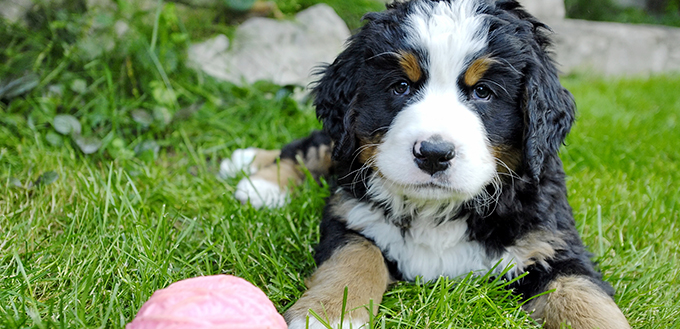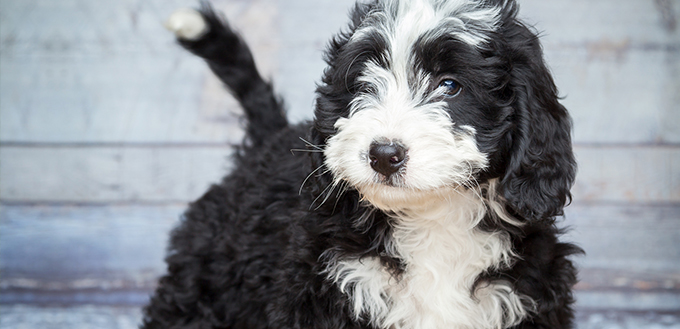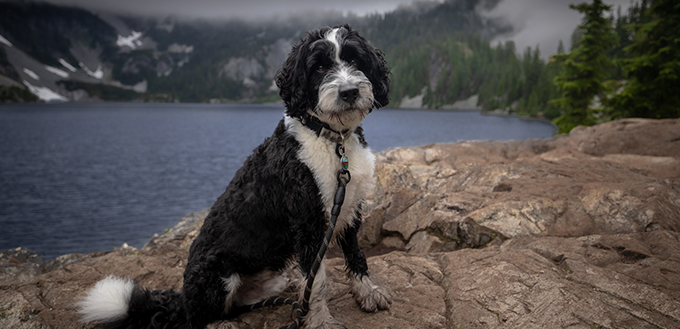Known for their high levels of intelligence and fierce loyalty, Bernedoodles are a mixed breed dog that have proven to be highly popular in recent years. Inheriting some of the best characteristics of both parents, there is no doubt that this is a dog who fills up the lonely hours with plenty of companionship. In this post, we are going to be taking a look at the breed in more detail, including the history, training, feeding, health, and temperament information.

History of the Bernedoodle
Unlike some dogs where it is difficult to trace back their exact origins, Bernedoodles were officially created by Sherry Rupke at Swissridge Kennels in 2003 after crossing Poodles with Bernese Mountain Dogs, though some may have existed before this date. Since they are a hybrid of two purebred dogs, they are not yet officially recognized by the American Kennel Club (AKC). While they are considered to be ‘designer dogs’, they do sometimes pop up in shelters and rescue homes as well. Even though they have been around for less than 20 years, they have already gained widespread popularity in the dog community.
Who are the Parents?
The parents of the Bernedoodle are the Bernese Mountain Dog and the Poodle in a 50/50 split. This F1 dog is believed to grow up much healthier than both parent breeds, and the offspring display a nice mix of characteristics from both dogs. There are also the F2 Bernedoodle puppies, which are not as sought-after as their parents. These come from parents who are both F1 Bernedoodles. While the litters tend to be more consistent and predictable there are also likely to be more health issues. Not only this, but some people believe the coats to be less attractive. If you are buying from a breeder, make sure that you get clear information about the origin story of your dog!
Quick Facts about the Bernedoodle
- When the Bernedoodle was first officially bred back in 2003, it was with the purpose of creating a great companion dog rather than one which would perform well in shows.
- How big do Bernedoodles get? Bernedoodles come in three sizes: tiny, miniature, and standard. Your Bernedoodle size depends on the genes that have been inherited from each parent. Tiny Bernedoodles grow up to 17 inches tall, Mini Bernedoodles up to 22 inches, and Standard Bernedoodle up to 29 inches. The Bernedoodle weight of the tiny version can be as little as 10 pounds, whereas the largest ones can come in at 90 pounds. In all cases, males are generally larger than females.
- You will notice that Bernedoodles vary significantly in appearance, depending on the traits received from the parents
- This is a very trainable dog – the stubbornness of puppyhood tends to fade as they get older.
- Since they don’t shed a huge amount, they are known to be a hypoallergenic dog.
- While they enjoy playing alone sometimes, this is certainly a companion dog who doesn’t enjoy being left alone for a long period of time.

Things You Should Know
Training
Training your dog is important in ensuring that they fit into your household with minimal issues. The tiny and miniature Bernedoodle versions of the dog tend to be especially excitable and a little stubborn in early age. For these reasons, socialization and training at an early stage are both important activities. You have a smaller window of training time than with some other breeds.
Many of the characteristics inherited from both parents make this a dog which is ideal for training – calmness, eagerness to please, and intelligence are just three of the main ones. Of course, all dogs are different and few, if any, of them are perfect! And just because these are trainable dogs, it doesn’t mean that everything is going to be plain sailing the whole time. You need to demonstrate plenty of patience and show consistency to achieve the positive results that you are looking for.
If you notice that your puppy is quite stubborn, this is something that tends to fade over time. As your dog grows up and you continue training them, you should notice that this headstrong nature starts to fade. But you need to keep going with the training. Without it, you could end up with a puppy who demonstrates behavioral issues later in life. You need to introduce your dog into a number of key situations to help them to adjust. Once you have taught the basics such as walking on a leash, sit, and stay, now is the time that you can move onto tricks, agility training, and other more complex activities. Take the training cues based on your dog. Don’t try to rush them before they are ready to move onto the next stage.
Feeding
As Bernedoodles vary vastly in their size, the correct amount to feed them varies significantly as well. It is also based on factors such as their age and activity levels. The bigger Bernedoodles are more likely to be gluttonous eaters, so you need to be more careful to watch their calorie intake. Obesity is one of the most dangerous conditions for a dog to get into, so make sure that you don’t let your dog overdo it. Exercise is also important in keeping your dog in trim condition. If you need any more information, it is worth getting in touch with your vet for more specific dietary recommendations.
Regardless of the size of your dog, you should ensure that you offer them good quality food from a reputable and trusted brand. When you still have a puppy, you should make sure that the kibble you are offering provides nutritional balance with all the necessary vitamins and minerals. While some owners opt for a raw food diet or one that involves cooking their own food. However, you need to be wary with diets of this kind as your dog can end up not getting enough nutrients if you are not careful. It is best to consult with a veterinary nutritionist if you are planning on going down this path.
Grooming
Sometimes Bernedoodle coats resemble Bernese Mountain Dogs more closely, whereas other times they are more like Poodles. Individual grooming activities vary from dog to dog, but generally, the curly coats don’t shed much, which makes them suitable for those with dander allergies. There are also Bernedoodles with straighter coats which shed more and are less hypoallergenic. As their coats are fairly thick, this makes them perfect for colder temperatures, but they also have a layer of protection against the summer sun too.
If your Bernedoodle dog has a curlier coat, this makes it harder to groom. As they don’t shed as much, you are going to need to step up your brushing activity to ensure that the coat doesn’t become matted. Many Bernedoodle owners decide to brush their dog as often as every day to keep it in good condition. Rather than seeing it as a chore, you can treat it as a bonding experience between the two of you. The coat should be trimmed every few months to reduce the chances of tangles and mats.
As for the coat color, this can vary. Some are black and brown, some are black and white Bernedoodles, and others are pure black. A few Bernedoodles have one of each of the three colors. Others also have elements of different colors too.
You May Also Like: Dog Shedding Brush
Health
In general, Bernedoodle dogs are a healthy breed of dog. While the purebred parents are known to have various health concerns, breeders of the F1 puppies have claimed that many of these have been eliminated after the two were bred. One of the main reasons for this is that the gene pool is much larger. However, this doesn’t mean that they are 100 percent healthy. A few common conditions in Bernedoodles include eye problems, hip dysplasia, and skin issues. Different types of Bernedoodle are also prone to a variety of health problems.
If you go through a professional breeder, they should genetically test both parents and litters to ensure the puppies are not predisposed to hereditary diseases. No one can predict with certainty how healthy a dog is going to be throughout their life. All you can do is to keep feeding your dog a healthy diet, as well as ensuring that they get enough exercise.
While Bernedoodles are new additions to the dog world, it is difficult to accurately estimate their life expectancy, but it seems to sit between 12 and 15 years at the moment.
Temperament
If you are a lover of Poodles or Bernese Mountain Dogs, you may well find that you have the best of both worlds in the Bernedoodle temperament. While the inherited traits vary, many owners report them having plenty of positive characteristics including intelligence, loyalty, and a fun-loving nature. As long as they have been properly socialized, they are known to be good around children and other dogs, which is why they are so popular as family pets.
One possible negative is the stubbornness which may come from the Bernese Mountain Dog parent. However, this often just lasts through puppyhood and will fade later in life through proper training. Socialization is also highly important as Bernedoodles can be a little wary of strangers, and you don’t want this apprehension to turn into full-on aggression.
Due to their high energy levels, tiny Bernedoodles need to get plenty of physical activity on a regular basis. However, the type of activity they get can vary depending on the household. For example, they will be happy to join you on your morning hike or jog, but you could equally let your pooch roam around your fenced backyard area. Remember that exercise depends on their size too. The smaller ones tend to be more active than the larger ones. A good walk is a must, but you don’t necessarily have to engage them in highly active and intense workout sessions.
As well as physical stimulation, it is important that your dog gets a mental workout as well. Offer them some puzzle toys and engage in some interactive games. Not only is this a good way of keeping their brains sharp, but it also ensures that they are tired at the end of the day, which helps to reduce any bad behavior.
While Bernedoodles can fit into different households with ease, this is still a highly social dog who loves being around people. Separation anxiety can be an issue, which is another point in the case of socialization. Many owners decide to go down the path of crate training at quite a young age. This gives your dog a safe space to retreat to whenever they are feeling anxious. With this in mind, they will not enjoy being in homes where they are left alone for an extended period of time. But this is a big part of the appeal for many owners. After all, this was a dog which was initially built for companionship in the first place.
While the tiny and miniature versions of the dog may be okay in apartments, the larger ones are better in larger houses with gardens.

Final Thoughts
There is a lot to love about Bernedoodles. Even though they are a relatively new breed of dog, it is easy to see why they have become so popular so quickly. Not only are they intelligent and loyal, but they are also loveable and friendly. All positive Bernedoodle characteristics, we’re sure you will agree. Grooming and exercise requirements are moderate, and they aren’t all that difficult to train either. There are plenty of breeders around offering this type of dog, but you can also find them in shelters with a bit of luck. If you are going down the former path, make sure that you choose a reputable breeder who has good recommendations and can provide you with all the necessary information that you are looking for.
You may also like our other breed guides on the: Australian Kelpie, Patterdale Terrier, Pudelpointer and Carolina Dog







